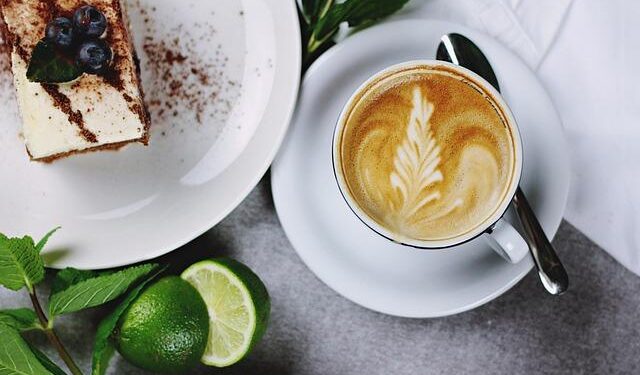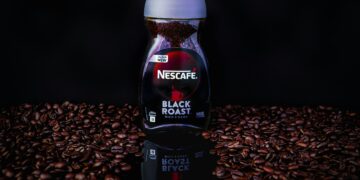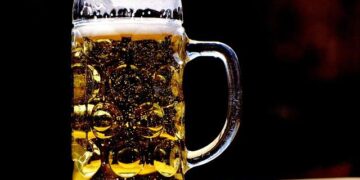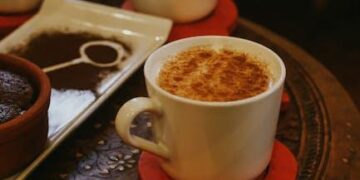Table of Contents
I remember the moment I gave up on the cold toddy.
It wasn’t a single bad drink, but the culmination of many failed attempts.
I was captivated by the idea: the soul-warming spices of a classic hot toddy, transformed into a crisp, refreshing cocktail perfect for a warm evening.1
The recipes I found online seemed simple enough—whiskey, citrus, honey, tea, and spices, served over i.e.3
Yet every batch I made was a disappointment.
They were either flat and one-dimensional or, far worse, aggressively unpleasant.
My breaking point came in the form of what I now call the “Bitter Rye Catastrophe.” I was preparing for a small get-together and decided to make a large batch.
I bought a beautiful, spicy rye whiskey and a collection of fragrant whole spices: cinnamon sticks, cloves, ginger, and cardamom.3
I followed the prevailing wisdom I’d seen everywhere: for a richer flavor, steep longer.
So, I combined everything in a large glass jar and let it sit for several days.
The liquid developed a gorgeous amber hue, and I was convinced I had finally cracked it.
The first sip was a disaster.
It was acrid, overwhelmingly bitter, and carried a harsh, vegetal quality that completely smothered the nuanced spice of the rye.
It was an undrinkable, expensive failure.
I had followed the rules, and they had led me straight to a drain-pour.
This frustrating experience forced me to ask a fundamental question: Why did a process that seemed so logical—more time equals more flavor—produce something so profoundly wrong? The standard advice was clearly broken, and I needed to find out why.
In a Nutshell: The New Rules for a Perfect Cold Toddy
For those short on time, here is the core philosophy that transformed my results:
- The Problem: Traditional, long-steeping infusions are a blunt instrument. They extract desirable aromas quickly but then continue to pull out undesirable bitter and astringent compounds from spices and peels over time, creating a harsh, muddled flavor.5
- The Solution: Stop thinking like a cook and start thinking like a perfumer. The goal is not just to “add flavor” but to perform a precise, targeted extraction of specific aromatic molecules.
- The Technique: Use modern, rapid infusion methods like a nitrous-charged iSi whipper or an ultrasonic homogenizer. These techniques capture the bright, fresh “top notes” of your ingredients in minutes, not days, avoiding the bitterness that comes with over-extraction.7
- The Method: Build your cold toddy in components. Create a clean, balanced spiced tea syrup separately. Rapidly infuse your spirit with fresh aromatics. Then, combine these perfected parts to create a cocktail that is bright, complex, and intentionally crafted.
The Epiphany: Thinking Like a Perfumer, Not a Bartender
My quest for a better cold toddy led me down a rabbit hole, far away from the world of mixology and into the meticulous science of perfumery.
I discovered that perfumers have been grappling with my exact problem for centuries: how do you capture the pure, delicate, and true essence of a botanical—a flower petal, a citrus peel, a piece of bark—without destroying it or extracting unwanted, harsh elements in the process?.9
This was my epiphany.
The answer wasn’t in a different recipe; it was in a different paradigm.
I began to see flavor not as a single entity, but as a complex composition of different chemical compounds, much like a perfume is built on a pyramid of notes.12
The techniques perfumers use are all designed to selectively capture these notes.
- Steam Distillation: This classic method uses hot steam to vaporize and carry away volatile aromatic oils.10 It’s powerful but can be too harsh for delicate flowers, analogous to how making a hot toddy can sometimes “cook” the fresh character out of the ingredients.
- Solvent Extraction & Enfleurage: These methods use a solvent (like alcohol or fat) to gently dissolve aromatic compounds from materials too fragile for heat.15 This is a direct parallel to the simple cold alcohol infusion—maceration—I had been attempting, but perfumers know its limitations.
- Supercritical CO2 Extraction: This is the modern ideal. It uses CO2 at low temperatures and high pressure to act as a “green solvent,” creating an incredibly pure extract that is remarkably true to the original plant.14 This technique represents the ultimate goal: a perfect, unaltered capture of flavor.
I realized that a perfect cold toddy isn’t about just “steeping spices in whiskey.” It’s about using the spirit as a solvent to perform a precise extraction of specific aromatic compounds.
The goal is to capture the bright, fleeting “top notes” (like fresh citrus) and the balanced “heart notes” (the warm spice character) while leaving behind the harsh, bitter compounds that emerge from over-extraction.
My Bitter Rye Catastrophe happened because my method—prolonged maceration—was a clumsy club when I needed a surgical scalpel.
It extracted everything, the good and the bad, resulting in a cacophony of flavor.
To fix the drink, I had to learn to compose it.
The “Base Notes”: Building a Resonant Foundation
In perfumery, the “base notes” are the foundation of the fragrance—the deep, long-lasting scents that anchor the entire composition.13
In our cold toddy, this foundation is built from three critical elements: the spirit, the sweetener, and the acid.
The Spirit as the Canvas
The choice of spirit is the most important decision you’ll make, as it provides the fundamental character of the drink.
Alcohol is a uniquely effective solvent, capable of dissolving both water-soluble compounds (which contribute to taste) and fat-soluble, non-charged aromatic compounds (which contribute to aroma), making it a perfect carrier for complex flavor.17
- Rye Whiskey: A classic choice, rye brings a spicy, peppery backbone that stands up beautifully to robust spices like cinnamon, clove, and cardamom.3
- Bourbon: Generally sweeter than rye, with notes of vanilla, caramel, and oak, bourbon pairs wonderfully with warmer spices like nutmeg and allspice, as well as orange and black tea.4
- Scotch Whisky: This category offers a wide spectrum. A balanced, malty blended Scotch works well with ginger and star anise.20 A smoky, peated Islay Scotch is a bold choice that can be stunning when paired with the complementary smoke of Lapsang Souchong tea.21
- Other Spirits: Don’t overlook dark rum or a quality brandy. Rum brings notes of molasses and tropical fruit that pair well with allspice and vanilla, while brandy offers a rich, fruity depth.22
The Sweetener and The Acid
These elements provide the essential balance.
Honey is the traditional sweetener, not just for its flavor but also for its antimicrobial properties, a nod to the toddy’s long history as a folk remedy for the common cold.24
However, maple syrup or a brown sugar simple syrup can create different and equally delicious profiles.19
Fresh lemon juice is the non-negotiable acid, providing the brightness needed to cut through the richness and prevent the drink from becoming cloying.26
A Nod to History
The toddy has a rich history that informs its core structure.
The name itself comes from the Hindi word “taddy,” referring to a beverage made from fermented palm sap, first noted in the 1610s.27
By 1786, the definition had evolved to mean a drink of “alcoholic liquor with hot water, sugar, and spices”.28
Interestingly, one of the earliest printed recipes for a toddy, from Samuel Sterns’ 1801
The American Herbal, was for a cold or room-temperature version made with rum or brandy, water, sugar, and nutmeg, described as a “salutary liquor, and especially in the summer season”.22
This proves the cold toddy isn’t a modern invention, but a return to the drink’s earliest roots.
Table 1: Spirit & Flavor Pairing Guide
| Spirit Type | Dominant Flavor Profile | Ideal Spice “Base Notes” | Ideal Citrus/Tea “Heart Notes” |
| Rye Whiskey | Spicy, Peppery, Assertive | Cinnamon, Clove, Black Cardamom | Orange, Earl Grey Tea |
| Bourbon Whiskey | Sweet, Vanilla, Oak | Nutmeg, Allspice, Vanilla Bean | Lemon, Black Tea |
| Blended Scotch | Balanced, Malty, Fruity | Ginger, Star Anise | Lemon, Apple Cider |
| Peated Scotch | Smoky, Medicinal, Briny | Lapsang Souchong Tea, Toasted Spices | Lemon, Fresh Ginger |
| Dark Rum | Molasses, Tropical Fruit | Cinnamon, Allspice, Vanilla Bean | Lime, Orange Bitters |
Capturing the “Heart & Top Notes”: The Science of Precision Extraction
With our foundation set, we now move to the most crucial and transformative part of the process: capturing the delicate, volatile “heart and top notes” of our spices and citrus.
This is where we leave behind the clumsy methods of the past and embrace the precision of the modern flavor architect.
The Old Way: Maceration (The Perfumer’s “Enfleurage”)
The method that led to my “Bitter Rye Catastrophe” is called maceration—simply steeping ingredients in a solvent (in this case, alcohol) in a sealed jar over time.7
While it’s the simplest technique, it’s also the least precise.
Alcohol is an aggressive solvent.
While it extracts the pleasant, volatile aromatic compounds relatively quickly, it continues to work on the solid material.
With prolonged contact, it begins to break down the cellular structure of woody spices and citrus peels, pulling out heavier, slow-releasing compounds like tannins and phenols.5
These are the culprits behind the bitterness, astringency, and “vegetal” off-flavors that ruined my rye infusion.5
This method doesn’t just infuse; it stews, killing the fresh top notes and creating a muddy, unbalanced final product.
The Modern Methods: Advanced Extraction (The Perfumer’s “CO2 Extraction”)
To achieve the clean, bright profile of a perfect cold toddy, we need techniques that offer speed and precision, capturing flavor without collateral damage.
Method 1: Nitrogen Cavitation (The iSi Whipper)
This technique, pioneered by culinary innovator Dave Arnold, uses a standard cream whipper and nitrous oxide (N₂O) chargers to achieve infusion in minutes.31
- The Science: When you charge the whipper, the high pressure forces the N₂O gas to dissolve into the spirit. This pressurized liquid is then forced deep into the porous structure of your solid ingredients (like a cinnamon stick or orange peel). The magic happens when you rapidly vent the whipper. The sudden drop in pressure causes the N₂O to violently expand and bubble out of the solid material, dragging the flavorful aromatic molecules along with it and dispersing them into the spirit.33
- The Result: You get a remarkably vibrant infusion in under five minutes. Because the contact time is so short, you capture the fresh, bright top notes of your ingredients without giving the alcohol time to extract the slow-releasing bitter compounds.32 This is the perfect method for delicate fresh herbs, citrus peels, and spices where you want a clean, zesty character.
Method 2: Ultrasonic Extraction (Sonication)
This is the cutting edge of flavor technology, using the power of sound to create intensely flavorful infusions.8
- The Science of Acoustic Cavitation: A probe-type ultrasonicator uses a titanium tip vibrating at a very high frequency (e.g., 20,000 times per second) to send powerful sound waves through the liquid.36 These waves create alternating cycles of low and high pressure. During the low-pressure cycles, microscopic vacuum bubbles form in the liquid. During the high-pressure cycles, these bubbles collapse—or implode—with incredible force.38 This phenomenon, called acoustic cavitation, creates localized zones of intense energy. The implosion generates powerful micro-jets and shear forces that act like a microscopic jackhammer, physically rupturing the cell walls of the botanical ingredients and releasing their contents directly into the spirit.36
- The Result: Sonication is the most efficient extraction method possible. It bypasses the slow process of solvent penetration and instead liberates the entire spectrum of flavor compounds almost instantly. This creates an incredibly rich, complex, and “full-spectrum” infusion that is truer to the source material than any other method.41 It can even be used to mimic the effects of barrel aging on spirits in a matter of minutes.8
Table 2: Infusion Technique Comparison: From Blunt Tool to Surgical Scalpel
| Technique | Time Required | Flavor Profile Captured | Key Advantage | Key Disadvantage | Best For… |
| Maceration (Jar Steeping) | Days to Weeks | Muddled, Prone to Bitterness | Simple, No Special Equipment | Slow, Inconsistent, High Risk of Over-extraction | Hardy ingredients where complexity is not the primary goal. |
| Nitrogen Cavitation (iSi Whipper) | 1-5 Minutes | Bright, Fresh, Top-Note Forward | Speed, Captures Delicate Aromas | Requires iSi Whipper & N₂O Chargers | Fresh citrus peels, delicate herbs (mint), pungent spices (chiles). |
| Ultrasonic Extraction (Sonication) | 30 Sec – 5 Min | Full-Spectrum, Intense, Complex | Ultimate Speed & Efficiency | Requires Specialized Equipment (Cost) | Woody spices (cinnamon), roots (ginger), creating complex profiles. |
The Perfumer’s Formulation: Crafting the Masterpiece Cold Toddy
Armed with this new understanding, we can now assemble our perfect cold toddy.
The key is to build it from meticulously crafted components, just as a perfumer blends different absolutes and essences to create a final fragrance.
Component 1: The Perfected Spiced Tea Concentrate
Instead of brewing tea and spices together, which can lead to a bitter, tannic mess, we will create them separately and combine them for maximum control.
Ingredients:
- 2 cups water
- 4 high-quality black tea bags (e.g., Earl Grey, English Breakfast) 4
- 1/2 cup honey
- 2 cinnamon sticks
- 6 whole cloves
- 1 star anise
Instructions:
- In a small saucepan, combine the water, honey, cinnamon sticks, cloves, and star anise.
- Gently heat the mixture over medium heat, stirring until the honey is fully dissolved. Do not boil.
- Remove the saucepan from the heat. Add the tea bags and steep for exactly 4 minutes. Steeping longer will extract excessive tannins from the tea, leading to bitterness.23
- Strain the mixture through a fine-mesh sieve into a clean jar, discarding the solids.
- Allow the concentrate to cool completely. It can be stored in the refrigerator for up to two weeks.
Component 2: The Rapid-Infused Spirit (iSi Whipper Method)
This is where we capture the bright, fresh soul of our spices and citrus without any of the harshness.
Ingredients:
- 250 ml Rye or Bourbon Whiskey
- 1 cinnamon stick, broken into coarse pieces
- 3 strips of fresh orange peel (use a vegetable peeler, avoid the white pith)
- 4 whole cloves
Instructions:
- Place the broken cinnamon stick, orange peels, and cloves into a 0.5 L iSi cream whipper.33
- Pour in the whiskey.
- Seal the whipper and charge with one N₂O cream charger. Shake gently for 30 seconds.
- Let the whipper rest for 2 minutes.
- Holding the whipper upright, rapidly vent all the gas by pressing the lever.
- Unscrew the top and strain the infused spirit through a fine-mesh strainer or coffee filter into a clean bottle.
The Final Assembly: The Ultimate Cold Toddy
This is the final blend, where our perfected components come together in harmony.
Recipe (for one serving):
- 2 oz (60 ml) Rapid-Infused Rye or Bourbon
- 1.5 oz (45 ml) Perfected Spiced Tea Concentrate
- 0.75 oz (22 ml) Fresh Lemon Juice
- Garnish: Fresh Orange Peel
Instructions:
- Fill a rocks glass with a single large ice cube.
- Add the infused spirit, spiced tea concentrate, and fresh lemon juice to the glass.
- Stir gently for 15-20 seconds until the outside of the glass is well-chilled.
- Take the fresh orange peel, hold it skin-side down over the drink, and squeeze it to express its fragrant oils over the surface.
- Rub the peel around the rim of the glass and drop it in as a garnish. Serve immediately.
Table 3: Infusion Timing Quick-Reference Guide
| Ingredient Type | Maceration Time (Jar) | iSi Whipper Time | Sonication Time |
| Fresh Citrus Peel (No Pith) | 1–3 Days | 1–2 Minutes | 30–60 Seconds |
| Hard Spices (Cinnamon, Clove) | 3–7 Days | 2–4 Minutes | 1–3 Minutes |
| Fresh Herbs (Mint, Rosemary) | 12–24 Hours | 1 Minute | 30 Seconds |
| Fresh Root (Ginger, Turmeric) | 2–4 Days | 3–5 Minutes | 2–4 Minutes |
| Hot Peppers (Habanero) | 2–12 Hours | 30–90 Seconds | 15–45 Seconds |
Troubleshooting Your Formulation: A Mixologist’s Field Guide
Even with the best techniques, challenges can arise.
Here’s how to diagnose and solve common infusion problems through the lens of our new paradigm.
- Problem: My infusion is bitter.
- Cause: You have over-extracted tannins and other bitter compounds.5 In maceration, this is caused by steeping too long. It can also be caused by using citrus pith.
- Solution: Reduce your infusion time drastically. If using maceration, taste every few hours, not days. Better yet, switch to a rapid technique. Always ensure every bit of white pith is removed from citrus peels. To attempt a salvage, a tiny pinch of salt can help suppress the perception of bitterness.5
- Problem: My infusion is cloudy.
- Cause: This is often due to pectin from fruit, tiny suspended solids from ingredients breaking down, or fusel oils from the spirit.42 It can also be “louching,” where dissolved oils fall out of solution when the spirit gets cold.43
- Solution: For suspended solids, strain thoroughly through a coffee filter or several layers of cheesecloth—this may be slow but is very effective.6 If the cloudiness appeared after chilling, try gently warming the spirit or adding a small amount of a higher-proof neutral spirit to help the oils redissolve.43
- Problem: My infusion tastes “dull” or “cooked.”
- Cause: The volatile top notes, which create the sensation of freshness and vibrancy, have been destroyed or driven off. This often happens with heat-based methods like sous-vide or simply by steeping for too long, which dulls the flavor profile.44
- Solution: This is a clear signal to use a non-thermal, rapid infusion method. The iSi whipper and sonicator excel at preserving the fresh, bright character of ingredients precisely because they work quickly and at room temperature.
- Problem: My infusion is too weak.
- Cause: The ratio of ingredients to spirit was too low, or the infusion time was insufficient for the chosen method.18
- Solution: Don’t be shy with your ingredients. Increase the solid-to-liquid ratio. For rapid methods, you can often perform the infusion a second time with the same ingredients to build more flavor intensity. And always use the freshest, most potent ingredients you can find.45
Conclusion: From Mixer to Composer
My journey with the cold toddy took me from a place of deep frustration to one of genuine creative excitement.
The “Bitter Rye Catastrophe” wasn’t just a failure; it was a catalyst that forced me to look beyond the conventional wisdom of the bar and into the precise science of the perfumer’s Lab. The success I found wasn’t just in a single good drink, but in a new philosophy—a replicable framework for thinking about flavor itself.
The paradigm shift is simple but profound: stop treating infusion as a passive act of waiting.
Start treating it as an active process of targeted extraction.
By understanding that flavor is a composition of chemical notes, and by choosing the right technique to capture the notes you desire, you move from being a simple mixer of ingredients to a composer of flavor.
The tools and techniques of the modern mixologist—the iSi whipper, the ultrasonic homogenizer—are the instruments that allow for this composition.
They empower you to create drinks that are not just delicious, but are delicious by design.
This is the art of the perfumer, brought to the bar.
It’s a path that transformed my craft, and it’s one that I encourage you to explore.
Works cited
- 8 Hot Toddy Variations – Cocktail Recipes – The Glenlivet, accessed July 24, 2025, https://www.theglenlivet.com/en/our-community/articles/hot-toddy-variations/
- Cold Toddy Whiskey Mule | Cupcakes & Kale Chips, accessed July 24, 2025, https://cupcakesandkalechips.com/cold-toddy-whiskey-mule/
- en.wikipedia.org, accessed July 24, 2025, https://en.wikipedia.org/wiki/Hot_toddy#:~:text=A%20cold%20toddy%20is%20made,until%20it%20is%20very%20cold.
- Spiced Cold Toddy – Spicewalla, accessed July 24, 2025, https://www.spicewallabrand.com/blogs/recipes/spiced-cold-toddy
- Infused vodka has a bitter, almost alkaline taste. : r/cocktails – Reddit, accessed July 24, 2025, https://www.reddit.com/r/cocktails/comments/7gk1bw/infused_vodka_has_a_bitter_almost_alkaline_taste/
- 5 Common Mistakes People Make With DIY Infusions – Serious Eats, accessed July 24, 2025, https://www.seriouseats.com/common-mistakes-diy-infusions-homemade-liqueurs-spirits
- A Bartender Guide to Infusion – Diageo Bar Academy, accessed July 24, 2025, https://www.diageobaracademy.com/en-zz/home/bartender-skills-and-techniques/a-bartender-guide-to-infusion
- Mixology: Ultrasonic Homogenizer for Cocktail Bars – Hielscher, accessed July 24, 2025, https://www.hielscher.com/mixology-ultrasonic-homogenizer-for-cocktail-bars.htm
- Meet Dominique Ropion, master nose of iconic perfumes – nss G-Club, accessed July 24, 2025, https://www.nssgclub.com/en/lifestyle/40934/dominique-ropion-french-perfumer-interview
- Capturing Fragrance in Its Purest Form – Advanced Biotech, accessed July 24, 2025, https://adv-bio.com/capturing-fragrance-in-its-purest-form/
- Extract Perfume: The Pure Essence of a Fragrance Unveiled – Pairfum London, accessed July 24, 2025, https://www.pairfum.com/extract-perfume-the-pure-essence-of-a-fragrance-unveiled/
- How Flavor Profiles Are Created in Food and Beverage Industries, accessed July 24, 2025, https://trilogyflavors.com/how-flavor-profiles-are-created-in-food-and-beverage-industries/
- Unlocking the Essence: How to Describe Perfume? – Be Layered, accessed July 24, 2025, https://www.belayered.com/blogs/blog/unlocking-the-essence-how-to-describe-perfume
- Extraction Methods – Olfactory NYC, accessed July 24, 2025, https://www.olfactorynyc.com/blogs/news/extraction-methods
- Perfume manufacturing techniques – Sylvaine Delacourte, accessed July 24, 2025, https://www.sylvaine-delacourte.com/en/guide/the-techniques-of-making-a-perfume
- Softact and perfume making – Paris – Bon Parfumeur, accessed July 24, 2025, https://www.bonparfumeur.com/blogs/journal/softact-in-the-perfume-making
- Notes on the Science of Flavour – Alcademics, accessed July 24, 2025, https://www.alcademics.com/2014/07/notes-on-the-science-of-flavour.html
- A Bartender Guide to Infusion – Diageo Bar Academy, accessed July 24, 2025, https://www.diageobaracademy.com/en-us/home/customer-service/a-bartender-guide-to-infusion
- The Best Spiced Bourbon Black Tea Hot Toddy Recipe, accessed July 24, 2025, https://littleblackskillet.com/spiced-bourbon-black-tea-hot-toddy/
- The Hot or Cold Toddy | Schnucks, accessed July 24, 2025, https://schnucks.com/recipes/the-hot-or-cold-toddy
- Hot Toddy – Food52, accessed July 24, 2025, https://food52.com/recipes/82307-our-best-hot-toddy
- Toddy – Chanticleer Society, accessed July 24, 2025, https://www.chanticleersociety.org/index.php?title=Toddy
- Spiced Tea Hot Toddy Recipe – The Spruce Eats, accessed July 24, 2025, https://www.thespruceeats.com/black-tea-hot-toddy-recipe-with-rum-764976
- Cold Toddy Shot Recipe | How To Make The Best Cocktail For A Cold – Mantitlement, accessed July 24, 2025, https://www.mantitlement.com/cold-toddy-shot/
- Hot Toddy Recipe (Soothe Your Cold & Cough) – The Cookie Rookie, accessed July 24, 2025, https://www.thecookierookie.com/cold-remedy-hot-toddy/
- Hot toddy Recipe | Scottish Cold Cure – Cailleachs Herbarium, accessed July 24, 2025, https://cailleachs-herbarium.com/2016/12/scottish-hot-toddy-recipe/
- The History of the Hot Toddy | VinePair, accessed July 24, 2025, https://vinepair.com/articles/history-of-hot-toddy/
- Hot toddy – Wikipedia, accessed July 24, 2025, https://en.wikipedia.org/wiki/Hot_toddy
- en.wikipedia.org, accessed July 24, 2025, https://en.wikipedia.org/wiki/Hot_toddy#:~:text=The%20word%20toddy%20comes%20from,as%20a%20’Hot%20Toady’.
- The Art of Infusion: Elevating Zero Proof Spirits with Flavor, accessed July 24, 2025, https://drinkcutabove.com/blogs/tips-hacks/infusions
- daily.sevenfifty.com, accessed July 24, 2025, https://daily.sevenfifty.com/the-science-of-rapid-liquor-infusion/#:~:text=The%20basic%20procedure%20is%20as,the%20whipper%2C%20and%20shake%20it.
- Instant Cocktail Infusions: A New Way to Use Your Cream Whipper | The Inspired Home, accessed July 24, 2025, https://theinspiredhome.com/articles/instant-cocktail-infusions-a-new-way-to-use-your-cream-whipper/
- Flavouring with Rapid Infusion » How it works – iSi, accessed July 24, 2025, https://culinary.isi.com/en-GB/culinary/applications/aromatise
- iSi Rapid Infusion Vodka Raspberry – YouTube, accessed July 24, 2025, https://www.youtube.com/watch?v=7Ll8YYGmj-Y&pp=0gcJCfwAo7VqN5tD
- Rapid Infusion with iSi Whipper or Sous Vide? – Amaro – Reddit, accessed July 24, 2025, https://www.reddit.com/r/Amaro/comments/awi7vt/rapid_infusion_with_isi_whipper_or_sous_vide/
- Ultrasonic Extraction and its Working Principle – Hielscher, accessed July 24, 2025, https://www.hielscher.com/ultrasonic-extraction-and-its-working-principle.htm
- A guide to the ultrasonic homogeniser – Class Magazine, accessed July 24, 2025, https://classbarmag.com/news/fullstory.php/aid/134/A_guide_to_the_ultrasonic_homogeniser.html
- Ultrasonic Cavitation in Liquids, accessed July 24, 2025, https://www.hielscher.com/ultrasonic-cavitation-in-liquids-2.htm
- Full article: Ultrasonication and food technology: A review – Taylor & Francis Online, accessed July 24, 2025, https://www.tandfonline.com/doi/full/10.1080/23311932.2015.1071022
- Overview and Toxicity Assessment of Ultrasound-Assisted Extraction of Natural Ingredients from Plants – MDPI, accessed July 24, 2025, https://www.mdpi.com/2304-8158/13/19/3066
- Spirits and Liquors – Rich Flavours by Ultrasonic Infusion, accessed July 24, 2025, https://www.hielscher.com/spirits-and-liquors-rich-flavours-by-ultrasonically-infusion.htm
- Why is my spirit cloudy? – Still Spirits, accessed July 24, 2025, https://help.stillspirits.com/hc/en-us/articles/360017838938-Why-is-my-spirit-cloudy
- How To Fix Cloudy Spirits – YouTube, accessed July 24, 2025, https://www.youtube.com/watch?v=aIqPYvJWyfk
- Sous vide spirit infusions – eGullet Forums, accessed July 24, 2025, https://forums.egullet.org/topic/130539-sous-vide-spirit-infusions/
- The Guide to Alcohol Infusions – Breakthru Beverage Group, accessed July 24, 2025, https://www.breakthrubev.com/news/alchemy/infusions
- DIY Infused Vodka – Reddit, accessed July 24, 2025, https://www.reddit.com/r/DIY/comments/1sbesd/diy_infused_vodka/






